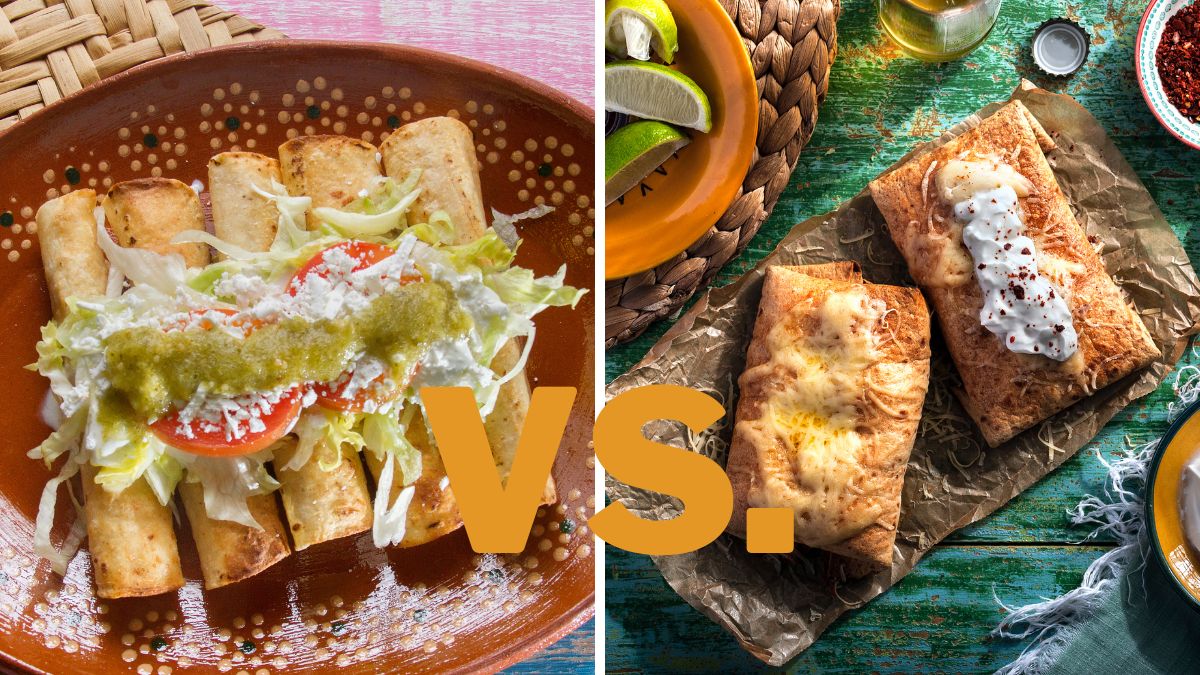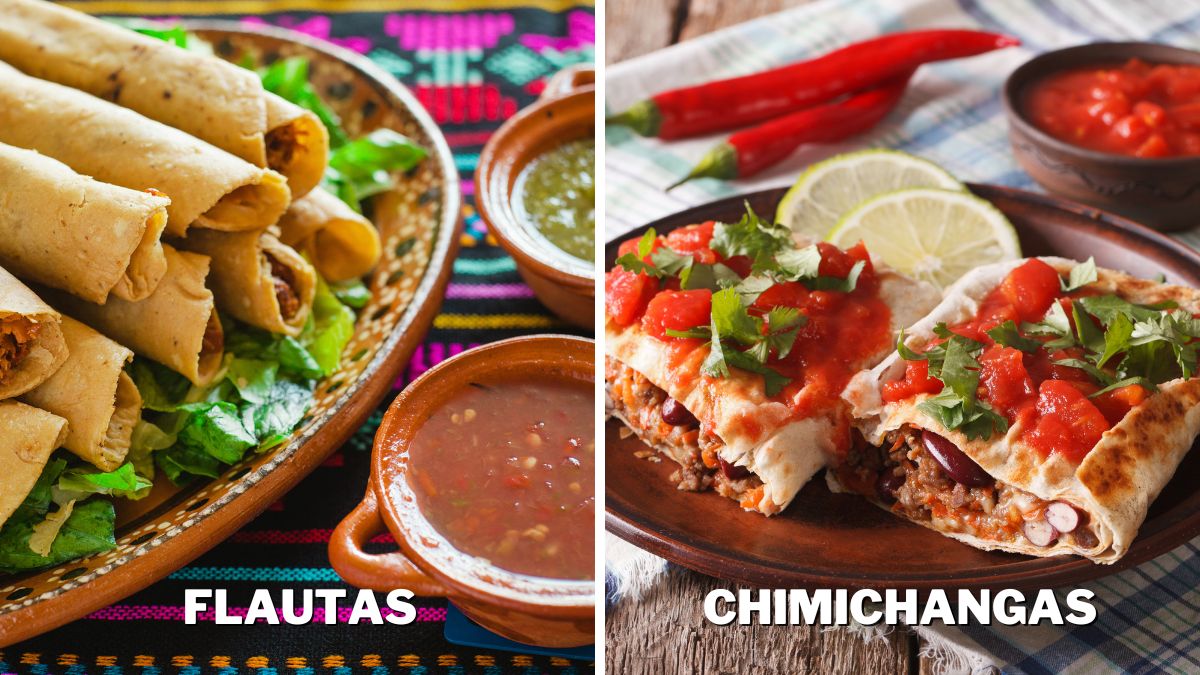Flautas vs. Chimichangas: Differences & Which Is Better

As a Tex and Mex enthusiast, I am always eager to try new recipes, experiment with existing ones, and, of course, dig deep and understand the differences between seemingly similar dishes. After a spirited conversation with a fellow Tex and Mex aficionado, I decided to share some of the fun info I gathered and the experience I acquired. Flautas and Chimichangas are both staples of Mexican cuisine and absolutely worth time under the spotlight. So, what are the differences between Flautas and Chimichangas?
Flautas are appetizers or side dishes, while Chimichangas are considered a main dish. Also, Flautas get softer as they cool, so Chimichangas are crunchier. Moreover, flautas give more room for experimentation with the filling than chimichangas.
It is easy to compare two absolutely different dishes, but the challenge arises when comparing very similar but different dishes, like Flautas and Chimichangas. To clear the air once and for all, in this article, I will tell you all about the differences between these dishes.
Key Ingredients that Set Flautas and Chimichangas Apart
Even though Flautas and Chimichangas use very similar core ingredients, they aren’t quite the same. The first time I made them, it seemed to me that these two delicacies were more or less identical until I felt the difference in ingredients up close.
Although there is no specific rule telling you that you can put certain ingredients in either Flautas or Chimichangas and should refrain from adding others, their respective traditional recipes call for a specific combination of ingredients.
Both Flautas and Chimichangas are made with corn tortillas and filling. The tortillas for Flautas are smaller and resemble a taquito. The filling is tightly secured inside the tortilla, resembling a smaller burrito.
The Flauta filling is often shredded meat (chicken, beef, or pork) combined with spices, beans, and cheese. I made my first Flauta with the most common and traditional filling, but once I got the hang of it, I started using rice, veggies, as well as mushrooms.
My point is, Flautas are Flautas as long as they resemble a flute. The filling can vary, and you can experiment as much as you feel creative. Just make sure you add savory ingredients, and not sweet. If you add sweet ingredients or fruits, that’s no longer a Flauta and gravitates towards a sweet Quesadilla with a different shape.
Chimichangas are more restrictive in their filling and don’t tolerate much experimentation. Chimichanga is a staple Tex-Mex dish, and the more it is changed, the further it gets from the real thing.
Like Flautas, Chimichangas also use flour tortillas, which are typically larger than those used for Flautas. The Chimichanga filling is similar to the Flauta filling, and it might include a wider range of ingredients, such as rice, refried beans, and a variety of meats and veggies.
The main difference in ingredients is that Flautas are traditionally served with beans, while rice and veggie fillings are more of a creative expression. Chimichangas traditionally offer a larger range of ingredients you can use.
That’s why I say that Chimichangas don’t tolerate as much experimentation as Flautas because they are already pretty open-ended. In addition to meat, veggies, rice, corn, cheese, and beans, even I don’t know what else you could add to Chimichanga to experiment with it.
Preparation of Fried Flautas and Oven-Baked Chimichangas

The preparation is probably where Flautas and Chimichangas differ the most. Both are very easy to prepare, considering that both are filled with pre-cooked filling. Generally speaking, both are very easy to prepare and don’t require much time or skill.
I think that the filling preparation is where the true mastery lies with these dishes. The filling for both is pre-cooked, regardless of whether or not it contains meat (Chimichangas can also be vegetarian).
The meat for both is well-done and finely shredded.
Flautas are typically rolled up and then fried until crispy, creating a crunchy exterior that contrasts with the tender filling inside. They look like a small burrito.
Chimichangas are larger than Flautas since they are made with a larger tortilla. While you wrap the filling tightly for a Flauta, the Chimichangas aren’t that snug. You just roll the tortilla around the filling and tuck the edges so that the filling doesn’t fall out.
Then, the Chimichangas are deep-fried or oven-baked.
Since the fillings for both Chimichangas and Flautas are pre-cooked, the baking/frying/deep-frying of the dishes doesn’t take longer than a few minutes. The trick is for the tortilla to get golden brown and crispy.
The Taste of Soft Flautas and Crunchy Chimichangas
If I were to find a word that describes both, it would be delicious. Still, there’s much more to say about what Chimichangas and Flautas taste like. Since they both typically contain cheese and meat, you can imagine how rich they are in flavors and textures.
While the Flautas get softer while cooling, they still offer the occasional crisp when you chew them. Since they are fried, the tortilla absorbs the juices from the filling and gets softer and softer as it cools.
If you have traditionally prepared Flautas, get ready for a flavor bomb bursting with meatiness and cheesiness. They are typically served with salsa, guacamole, sour cream, or shredded cheese, so you are guaranteed to experience zest, creaminess, and decadence with each bite.
My burrito version of the Flautas also contains rice and beans, and I am simply in love with the grainy and extra creamy texture.
Chimichangas are also incredibly delicious dishes, offering abundant flavor notes and textures. Since it is deep-fried or baked, the tortilla is covered in a crispy crust that crumbles once you bite into it, creating a delightful crunch, further enriching the texture of the dish.
Since they, too, are traditionally filled with meat and cheese, though they can be made with rice, beans, and veggies, Chimichangas offer a variety of flavors in a single bite. Since the traditional sides for Chimichangas are Mexican rice, mango salsa, or cilantro coleslaw, prepare for savory, slightly sweet, and slightly sour notes that intensify the already present richness of the dish.
Variations on Original Flautas and Chimichanga Recipes
As I mentioned before, both Flautas and Chimichangas offer a wide range of experimenting possibilities and creative expressions. Because Flautas are typically made with shredded meat and cheese, adding rice, beans, or veggies to them constitutes experimentation since these additional ingredients aren’t a part of the original recipe.
On the other hand, there are traditional Chimichanga styles that include rice, beans, and veggies, in addition to meat and cheese or as the main filling ingredients. Therefore, I would say that Flautas offer a wider range of variations since Chimichanga variations fall under the traditional style.
Feel free to be as creative as you want with both, and enjoy making and having them. I want to do something slightly differently each time I make them, and they turn out great, so don’t be afraid to experiment.
Serving Flautas as Appetizers and Chimichangas as Main Dish

Since Flautas are smaller in size than Chimichangas, they are considered appetizers and are served as an ensemble of three or more pieces in a serving. They are often paired with the main dish and are used as sides.
Even though I usually make a bunch and have them as the main dish, I sometimes serve and have Flautas the traditional way with a larger meal, such as chili or something similar.
They often come with fresh salsa, guacamole, sour cream, or shredded lettuce or cheese, but you can serve them with any other sauce or dip. I’ve had them with marinara, mayo, ketchup, tartar sauce, and honey mustard, and they work with everything.
On the other hand, Chimichangas are the main course and are served as a complete meal. The serving usually includes one large Chimichanga plated alongside sides like rice, beans, and salad.
You can also serve them with a salad, a side of fries, chicken wings, or another snack you like. Toppings, dips, and sauces are always a very welcome enrichment, so go wild with your favorite ingredients.
Distinct and Partially Shared Origins
Flautas have strong Mexican roots and are deeply connected to the country’s culinary traditions. They have been invented by the indigenous people and named after their shape- a flute. To this day, they are a very popular dish, especially among street food lovers, but are also commonly made at home and in restaurants.
Chimichangas have a bit of a contested origin, with claims from both Mexico and the southwestern United States. Among the theories of the origin of this dish, there is one claiming that they were created by accident.
Allegedly, the first Chimichanga was a burrito that fell into hot oil and was deep-fried unintentionally. It turned out that this fried burrito was delicious, so it got very popular as a separate dish. Chimichangas are very popular worldwide, and they are part of the menus of all Mexican restaurants.
Which Is Better, Flautas or Chimichangas?
If you’re looking for party food, flautas are an obvious choice, while if you want to make a delicious and crunchy meal for friends and family, you should go with chimichangas. Also, if you’re looking for a dish to experiment with, I would rather go with flautas since chimichangas don’t really tolerate experimentation.
To say which is better would be very unappreciative because, objectively, there’s no correct answer. I enjoy both, and I honestly can’t say which is better, even if one is genuinely superior.
I’ll let you be the judge and see for yourself which one of these delights is the better one for you. Still, I would love to know which one you like better, so write it down in the comments below!
